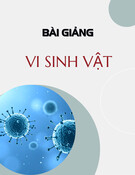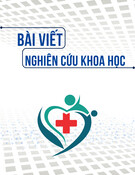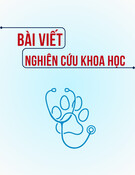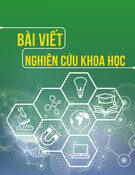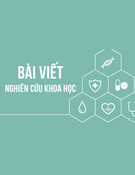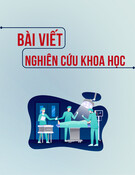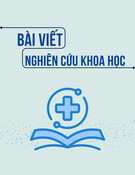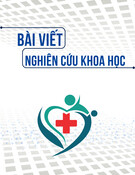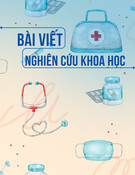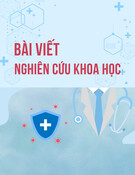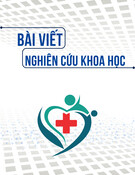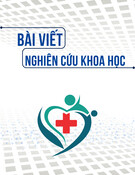
TNU Journal of Science and Technology 230(04): 196 - 203
http://jst.tnu.edu.vn 196 Email: jst@tnu.edu.vn
ENHANCING NURSING STUDENTS’ ENGLISH-SPEAKING SKILLS
THROUGH MULTIMEDIA: AN ACTION RESEARCH
AT HAI DUONG MEDICAL TECHNICAL UNIVERSITY
Vu Thi Hong Ly*, Pham Thi Xuyen
Hai Duong Medical Technical University
ARTICLE INFO ABSTRACT
Received:
12/11/2024
This study evaluates the effectiveness of using multimedia tools to improve the
English-
speaking skills of nursing students at Hai Duong Medical Technical
University.
The research aims to determine the extent to which multimedia
tools enhance students' English speaking skills. Thirty pre-
intermediate nursing
students participated in two cycles of action research
. The study was conducted
at Hai Duong Medical Technical University in the academic years of 2016-
2017. Multimedia tools, such as videos, audio reco
rdings, and animations, were
incorporated into traditional English speaking lessons. Data was collected
through a combination of pre- and post-
tests, classroom observations, field
notes, and student interviews
to gather both quantitative and qualitative data.
Quantitative findings
indicated a significant improvement in the students'
speaking skills, particularly in pronunciation, fluency, grammar accuracy, and
vocabulary use, with an average increase of 15% in overall speaking scores.
Qualitative data highlighted that students found the multimedia-
enhanced
lessons to be highly interactive, engaging, and closely aligned with their
medical professional goals.
The study concludes that integrating multimedia
tools into English language teaching can be an effective strategy for improving
speaking skills
, especially in specialized fields like medical training.
Revised:
27/3/2025
Published:
28/3/2025
KEYWORDS
Multimedia tools
English speaking skills
Quantitative and qualitative
data
Nursing students
Medical scenarios
SỬ DỤNG CÔNG CỤ ĐA PHƯƠNG TIỆN NHẰM NÂNG CAO KỸ NĂNG NÓI
TIẾNG ANH CHO SINH VIÊN ĐIỀU DƯỠNG: NGHIÊN CỨU HÀNH ĐỘNG
TẠI TRƯỜNG ĐẠI HỌC KỸ THUẬT Y TẾ HẢI DƯƠNG
Vũ Thị Hồng Lý
*
, Phạm Thị Xuyên
Trường Đại học Kỹ thuật Y tế Hải Dương
THÔNG TIN BÀI BÁO TÓM TẮT
Ngày nhận bài:
12/11/2024
Nghiên cứu này đánh giá hiệu quả của việc sử dụng các công cụ đa phương tiệ
n
trong việc cải thiện kỹ năng nói tiếng Anh của sinh viên điều dưỡng tại Trườ
ng
Đại học Kỹ thuật Y tế Hải Dương. Mục tiêu của nghiên cứu là xác định mức độ
mà các công cụ đa phương tiện có thể nâng cao kỹ năng nói tiếng Anh củ
a sinh
viên. Ba mươi sinh viên điều dưỡng trình độ tiền trung cấp đ
ã tham gia vào hai
chu kỳ nghiên cứu hành động. Nghiên cứu được thực hiện tại Trường Đại họ
c
Kỹ thuật Y tế Hải Dương trong năm học 2016-2017. Các công cụ
đa phương
tiện, chẳng hạn như video, bản ghi âm và hoạt hình, đã được tích hợ
p vào các
bài học nói tiếng Anh truyền thống. Dữ liệu được thu thập thông qua sự kết hợ
p
giữa các bài kiểm tra trước và sau, quan sát lớp học, ghi chép thực địa và phỏ
ng
vấn sinh viên để thu thập cả dữ liệu định lượng và định tính. Kết quả định lượ
ng
cho thấy sự cải thiện đáng kể về kỹ năng nói của sinh viên, đặc biệt là ở
các khía
cạnh phát âm, lưu loát, độ chính xác ngữ pháp và sử dụng từ vựng, với mứ
c tăng
trung bình 15% trong tổng điểm nói. Dữ liệu định tính nhấn mạnh rằ
ng sinh viên
cảm thấy các bài học có sử dụng đa phương tiện rất tương tác, thú vị và phù hợ
p
chặt chẽ với mục tiêu nghề nghiệp y tế của họ. Nghiên cứu kết luận rằng việ
c
tích hợp các công cụ đa phương tiện vào giảng dạy tiếng Anh là một chiến lượ
c
hiệu quả để cải thiện kỹ năng nói, đặc biệt trong các lĩnh vực chuyên biệ
t như
đào t
ạ
o y t
ế
.
Ngày hoàn thiệ
n:
27/3/2025
Ngày đăng:
28/3/2025
TỪ KHÓA
Phương tiện hỗ trợ giảng dạy
đa phương tiện
Kỹ năng nói tiếng Anh
Dữ liệu định lượng và định
tính
Sinh viên điều dưỡng
Môi trường đào tạo y khoa
DOI: https://doi.org/10.34238/tnu-jst.11539
* Corresponding author. Email: ly.vuthong@gmail.com

TNU Journal of Science and Technology 230(04): 196 - 203
http://jst.tnu.edu.vn 197 Email: jst@tnu.edu.vn
1. Introduction
The need for proficient English communication skills has surged, particularly in the healthcare
field, where effective communication is essential for patient care and professional collaboration.
English proficiency is critical for healthcare professionals to engage in international medical
exchanges, patient consultations, and conferences [1]. However, in Vietnam, many medical
students struggle to develop strong English-speaking skills despite years of formal education.
Traditional English instruction at institutions such as Hai Duong Medical Technical University
(HMTU) has often emphasized grammar and vocabulary over communicative competence,
leaving students with theoretical knowledge but limited practical speaking abilities [2].
Multimedia teaching aids, such as videos, audio clips, and interactive animations, have
increasingly been recognized as valuable tools for enhancing language learning. Recent studies
show that multimedia fosters an engaging, interactive environment that improves language
retention, fluency, and student motivation [3], [4]. In healthcare education, integrating
multimedia resources enhances language proficiency and provides context-rich scenarios, where
students can practice speaking skills relevant to their future medical careers [4]. Furthermore,
mobile learning platforms, such as AFORN, have proven effective in significantly improving
English-speaking skills among nursing students by offering flexible and accessible practice
opportunities [5]. Additionally, research has shown that incorporating communicative teaching
techniques, such as multimedia-enhanced simulations, can better equip healthcare professionals
to handle real-life medical communication [6].
This action research explores how multimedia teaching aids can improve English as a Foreign
Language (EFL) speaking skills among nursing students at HMTU. It investigates how
multimedia tools can help students overcome challenges in fluency, pronunciation, grammar
accuracy and vocabulary use. The research aims to determine the extent to which multimedia
tools enhance students' English speaking skills. In the healthcare field, where precise and
confident communication is essential, the development of these skills is particularly valuable [7].
This research also demonstrates that multimedia-enhanced lessons provide a holistic learning
experience, addressing essential linguistic competencies for nursing students. This approach
builds confidence and prepares students for professional medical interactions, where clear
communication is crucial [8].
2. Methodology
2.1. Research design
The action research model used in this study is characterized by its cyclical process, which
involves continuous steps of planning, action, observation, and reflection. Action research allows
practitioners to systematically investigate their own teaching practices and make necessary
adjustments in real-time. By continuously reflecting on their actions, lecturers can identify
solutions to classroom challenges and improve instructional strategies, thereby enhancing student
outcomes. This method is particularly effective in educational settings, as it fosters both personal
and collective change. On a personal level, the teacher gains deeper insights into their
pedagogical approaches, while on a collective level, improvements are shared with the larger
community of educators to foster collaborative learning and development [9]. Two action
research cycles were implemented in this study to assess the impact of multimedia on students'
speaking skills. The cyclical process enabled the researcher to partly improve the teaching
approach based on student feedback and performance outcomes after each cycle [10]. This
adaptive method ensured that the intervention was tailored to meet the specific needs of the
students in a dynamic learning environment.

TNU Journal of Science and Technology 230(04): 196 - 203
http://jst.tnu.edu.vn 198 Email: jst@tnu.edu.vn
2.2. Participants and setting
The participants of the study were 30 nursing students enrolled in a compulsory English-
speaking course at HMTU. These students had varied levels of English proficiency, with most at
the pre-intermediate level. The participants were selected because of their need to improve
speaking skills, particularly in medical communication contexts. The course aimed to prepare
them for professional interactions in English, such as patient consultations, presentations at
medical conferences, and discussions with international colleagues.
The classroom environment provided a traditional lecture setup, but multimedia tools such as
projectors and speakers were available. These tools were used to integrate multimedia content,
such as medical scenario videos, dialogues, and pronunciation guides, into daily lessons.
2.3. Research procedure
A four-stage action research model consisting of planning, action, observation, and reflection
which is based on the foundational work of Kemmis and McTaggart, referenced in [11] was
applied in this study. The stages are illustrated in Figure 1.
Figure 1. Four-stage action research model
This study retains the core elements of the model but includes specific adjustments to better
suit the research objectives. This cyclical approach allows for ongoing problem-solving and
iterative refinements to teaching methods, based on the outcomes observed at each stage.
The action research consisted of two cycles, each following the stages of planning, action,
observation, and reflection. The specific details of each cycle are outlined below:
2.3.1. Cycle 1: Initial Implementation: Conducted over four weeks.
Planning: The researcher collaborated with an English teacher to develop lesson plans
incorporating multimedia tools. These plans focused on key competencies, including
pronunciation, fluency, and medical vocabulary. Videos and audio recordings depicting medical
scenarios were selected to provide authentic and relevant language practice. A pre-test was
administered to assess the students' baseline speaking skills.
Action: Two lessons were delivered per week, each lasting 90 minutes. Activities included:
Vocabulary practice: Matching English terms with Vietnamese equivalents and pronunciation drills.
Video analysis: Students watched medical scenario videos to identify language functions and
expressions.
Role-play: Students acted out dialogues based on the videos, practicing real-life medical
communication.
Observation: Data were collected through field notes, observation checklists, and students’
interviews. The researcher monitored student engagement, participation, and speaking
proficiency.

TNU Journal of Science and Technology 230(04): 196 - 203
http://jst.tnu.edu.vn 199 Email: jst@tnu.edu.vn
Reflection: At the end of Cycle 1, the researcher analyzed the data to identify strengths and
areas for improvement. A post-test was conducted to evaluate progress in speaking skills. It was
observed that students struggled with pronunciation and lacked confidence in spontaneous
speaking. Adjustments were planned for Cycle 2 to address these challenges.
2.3.2. Cycle 2: Refinement and Expansion: Conducted over other four weeks.
Planning: Based on Cycle 1 reflections, lesson plans were revised to include explicit
pronunciation feedback and more opportunities for spontaneous speaking. Additional multimedia
resources, such as interactive animations, were introduced. Another pre-test was administered to
assess the adjusted baseline for Cycle 2.
Action: Two lessons per week were again conducted. Activities included:
Pronunciation workshops: Focused on challenging medical terms, with students receiving
immediate feedback.
Interactive simulations: Students engaged in unscripted role-plays using situation cards to
simulate patient consultations.
Group discussions: Facilitated peer learning and increased speaking confidence.
Observation: The researcher and collaborating teacher used similar observation methods as in
Cycle 1, with added emphasis on tracking progress in spontaneous speaking and confidence levels.
Reflection: Post-Cycle 2, the data showed significant improvements in students' speaking
skills, particularly in pronunciation and fluency. Another post-test was conducted to measure the
final improvements. Students also reported increased confidence and enjoyment in their learning
experience.
2.4. Data collection and analysis
Quantitative data were gathered through pre- and post-tests, assessing pronunciation, fluency,
grammar, and vocabulary. A standardized rubric adapted from Brown [12] was used to evaluate
performance, and improvements were analyzed statistically. Qualitative data were collected via
classroom observations, student interviews, and field notes. Thematic analysis was employed to
identify patterns in student engagement, confidence, and perceived effectiveness of multimedia tools.
The iterative nature of the two cycles ensured continuous refinement of teaching strategies,
ultimately contributing to the study’s success in enhancing nursing students' English-speaking skills.
3. Results and Discussion
This section presents the findings of the study in two parts: quantitative results from the pre-
test and post-test, and qualitative results from classroom observations, student interviews, and
field notes. The findings demonstrate the positive impact of multimedia teaching aids on English-
speaking skills in the context of medical training.
3.1. Improvement in speaking skills
The pre-test and post-test scores revealed notable improvements across all areas of speaking
proficiency: pronunciation, fluency, vocabulary use, and grammatical accuracy. Table 1 shows
the mean score improvements for each area of speaking and overall improvement.
Table 1. Improvement in speaking skills based on pre-test and post-test mean scores
Indicators Pre-test mean score Post-test mean score Improvement
Pronunciation
3.5
4.0
14.3%
Fluency
3.2
3.7
15.6%
Vocabulary
3.8
4.4
15.8%
Grammar
3.9
4.4
12.8%
Overall
3.6
4.1
15.0%

TNU Journal of Science and Technology 230(04): 196 - 203
http://jst.tnu.edu.vn 200 Email: jst@tnu.edu.vn
The greatest improvement was observed in vocabulary (15.8%), followed closely by fluency
(15.6%). This is likely due to repeated exposure to video dialogues and pronunciation guides
provided during the lessons. Videos featuring medical scenarios allowed students to hear and
replicate the correct pronunciation of complex medical terms. Fluency improved as students
engaged in role-play activities that required them to communicate in real-time, enhancing their
ability to speak spontaneously and confidently [13], [14].
The substantial progress in pronunciation (14.3%) and grammatical accuracy (12.8%) can be
attributed to the multifaceted nature of the multimedia resources employed. These tools provided
students with contextual learning opportunities, allowing them to internalize new lexical items
and grammatical structures within relevant medical contexts. The interactive nature of the
multimedia aids facilitated active engagement with the language, promoting retention and
practical application of newly acquired linguistic skills [15], [16].
A standardized rubric adapted from Brown [12] was used to measure speaking proficiency.
The rubric was adapted to address the specific context of the study, particularly vocabulary use in
medical terminology. Speaking tests were evaluated by two raters using the rubric. The inter-rater
reliability was calculated to ensure consistency in scoring.
3.2. Qualitative results
Thematic analysis of the qualitative data, from observations, field notes, and student
interviews, revealed several key findings related to student perceptions of the multimedia-
enhanced instruction. First, multimedia tools made the lessons more engaging and interactive.
Students appreciated the use of videos and audio clips as these tools provided them with real-
world examples of spoken English in medical settings [16]. Second, multimedia tools
significantly reduced students' fear of making mistakes. Students felt more confident practicing
English in role-plays after watching video demonstrations of doctor-patient dialogues. The
reduction in anxiety allowed them to participate more actively in speaking activities, fostering a
supportive learning environment [17], [18]. Finally, the multimedia approach helped students
connect theoretical knowledge of medical vocabulary with practical usage. Students mentioned in
the interviews that multimedia tools helped them retain new vocabulary more effectively, as they
could see the words being used in context [19].
3.3. Discussion
This study's findings demonstrate a strong correlation between the quantitative and qualitative
data, revealing the impact of multimedia teaching aids on English speaking skills in medical
contexts. The analysis shows several points of consistency and a few areas of potential
inconsistency. Quantitative results indicated significant improvements in students' pronunciation
and fluency scores, which aligned with qualitative feedback from interviews where students
reported increased confidence in their speaking abilities after exposure to video dialogues and
pronunciation guides. Both data sets suggest that repeated exposure to authentic medical English
through multimedia aids enhances pronunciation accuracy and speaking fluency. Furthermore,
quantitative data revealed increased participation in speaking activities, corroborating qualitative
feedback from field notes describing multimedia-enhanced lessons as more engaging and
interactive. This consistency implies that multimedia aids effectively boost student motivation
and active participation in language learning. While not directly measured in quantitative scores,
qualitative data from observation checklists strongly indicated a reduction in students' fear of
making mistakes, correlating with improved fluency scores and suggesting that a supportive
learning environment contributes to better speaking performance.
However, some potential inconsistencies were noted. Despite quantitative improvements
across all areas, including vocabulary and grammar, qualitative feedback focused primarily on
pronunciation and fluency, possibly indicating that students were less aware of their progress in

![Bài giảng Giải phẫu học tứ chi, đầu mặt cổ [mới nhất]](https://cdn.tailieu.vn/images/document/thumbnail/2025/20250805/vijiraiya/135x160/14821754390490.jpg)
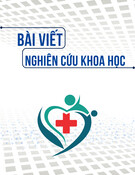
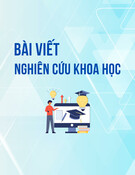


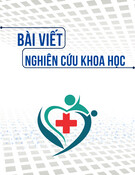




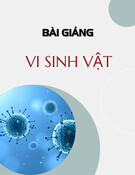
![Bài giảng Vi sinh vật: Đại cương về miễn dịch và ứng dụng [chuẩn nhất]](https://cdn.tailieu.vn/images/document/thumbnail/2025/20251124/royalnguyen223@gmail.com/135x160/49791764038504.jpg)
